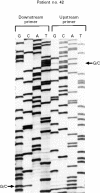K-ras mutations in patients with early colorectal cancers
- PMID: 9378386
- PMCID: PMC1891500
- DOI: 10.1136/gut.41.3.323
K-ras mutations in patients with early colorectal cancers
Abstract
Background: Published data are contradictory about the importance of K-ras mutations in advanced tumours and are not available for early cancers.
Aims: To establish whether specific K-ras mutations are prognostic markers in early stage colorectal adenocarcinoma.
Methods: The presence of K-ras exon 1 mutations were correlated with tumour recurrence in two groups of patients: group 1 was a consecutive series of patients with resected colorectal adenocarcinoma at low risk of recurrence; group 2 were patients referred for chemotherapy after relapse of previously resected early stage tumours. K-ras mutations were detected by direct sequencing of whole tissue samples in all patients and in some, the leading edge and centre of the tumour were also microdissected out individually and sequenced.
Results: Mutations were present in 26 (26.5%) of 98 patients in group 1; 14 patients developed a recurrence, four (28.5%) of whom had a K-ras mutation. Seventy nine patients have not developed tumour recurrence, 22 (28%) of whom had a mutation (p = 0.84). K-ras mutations were present in five of 14 patients in group 2. Microdissection did not increase the number of mutations detected.
Conclusions: Individual K-ras genotypes are distributed homogeneously throughout early stage colorectal adenocarcinomas, but detection of a mutation has no apparent prognostic value.
Figures



References
Publication types
MeSH terms
LinkOut - more resources
Full Text Sources
Medical
Miscellaneous
